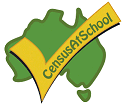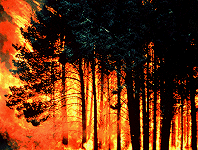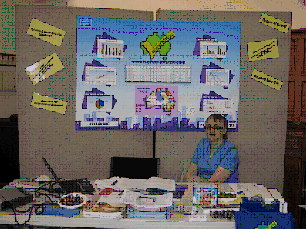Education News - May 2008
This newsletter highlights the latest curriculum related teaching resources, student activities and statistical tools that have been developed by ABS Education Services as well as other ABS resources that are useful for schools.
Contents
- CensusAtSchool 2008 - Make Your School Count
- An Idea for the Classroom - Natural Disasters in Australia
- Successful Teacher Librarian Information Sessions
- Explore Your Capital City (and a few others)
- Not Just for Librarians
- Test Your Water Knowledge
- Australian Statistics Poster Competition
- Conference Participation
- Recently Released Publications
- Contact details
1. CensusAtSchool 2008 - Make Your School Count
 ‘My students loved using the CensusAtSchool data,’ said Richard Hennell from Tumby Bay Area School in South Australia. ‘From Year 8 to Year 12 they used it to research and test claims. Young people are curious about how they compare with other students around Australia. This year more students from our school will have the opportunity to respond to the questionnaire and so be part of the data that they later analyse. ’
‘My students loved using the CensusAtSchool data,’ said Richard Hennell from Tumby Bay Area School in South Australia. ‘From Year 8 to Year 12 they used it to research and test claims. Young people are curious about how they compare with other students around Australia. This year more students from our school will have the opportunity to respond to the questionnaire and so be part of the data that they later analyse. ’
There are now less than 80 days to go until the 2008 CensusAtSchool Questionnaire closes. Help your students get the most out of the data by ensuring that all students in your school (from Years 5 to 12) submit a questionnaire and encouraging other schools in your area to have students submit a questionnaire. This is particularly important in country areas where there are fewer schools, resulting in a limited number of responses. Data collection closes on July 4. DON'T MISS OUT!
The 2008 database will be open for data analysis in July 2008, and will be supported by a range of classroom activities for use in ICT, Mathematics and SOSE/HSIE. However the project's diverse use extends as far as English and Health. More than 87,000 students and teachers have accessed the 2006 database from the CensusAtSchool website via the Random Sampler facility and countless others have downloaded the prepared samples. The good news this time is that data from the Random Sampler will be delivered as an Excel spreadsheet ready for analysis.
CensusAtSchool is designed for students between Years 5-10, but extends to senior levels too, allowing such analyses as binomial distributions and linear regression. And of course CensusAtSchool is available FREE online.
The best part is how quick and easy it is for schools to participate!
Remember if yours students are a part of the data, they will be more eager to analyse it.
2. An Idea for the Classroom - Natural Disasters in Australia
The United Nations General Assembly has proclaimed 2008 to be the United Nations International Year of Planet Earth a joint initiative by the International Union of Geological Sciences (IUGS) and the United Nations Educational, Scientific and Cultural Organisation (UNESCO).
 The Year Book Australia, 2008 includes three articles that relate to this theme: Understanding Natural Hazard Impacts on Australia, Natural Disasters in Australia and Tsunami Risk to Australia. All three articles are a great resource for students examining natural disasters and geohazards.
The Year Book Australia, 2008 includes three articles that relate to this theme: Understanding Natural Hazard Impacts on Australia, Natural Disasters in Australia and Tsunami Risk to Australia. All three articles are a great resource for students examining natural disasters and geohazards.
In the first article, Miriam Middlemann from GeoScience Australia looks at a number of natural hazards that Australia faces: flood, bushfire, cyclone, severe storm etc. and the risk reduction strategies to deal with these and other threats.
Natural Disasters in Australia, is packed with information and photos of some of Australia's worst natural disasters from the drought of 1895 to the Gippsland floods last year.
Finally Tsunami Risk to Australia discusses the risk and response of such an event and includes an excellent diagram showing how a tsunami develops.
Do you have a classroom idea that uses ABS data or ABS Education products? Let us know at education@abs.gov.au and we can share it around Australia.
| See below for an article submitted for Literacy/ESL. |
 |
3. Successful Teacher Librarian Information Sessions
 Teacher Librarians left the Education Services Information sessions in Victoria, keen to start using the ABS resources they discovered and keen to pass the information on to other teachers at their schools. All participants found the course very worthwhile and said that what they had learned would be useful back at school and that they would recommend the session to others. Teacher Librarians left the Education Services Information sessions in Victoria, keen to start using the ABS resources they discovered and keen to pass the information on to other teachers at their schools. All participants found the course very worthwhile and said that what they had learned would be useful back at school and that they would recommend the session to others.
If you missed these sessions, you can still attend the free 2006 Census Information Sessions. These are being run in the Victorian, South Australian, West Australian and Tasmanian offices of the ABS throughout 2008. Although they are not specifically for teacher librarians, the information will be extremely useful for schools. You can also see what other services are offered to librarians on the Services for Libraries page of the ABS website.
As well, Education Services is currently negotiating to have information sessions specifically for teacher librarians run in capital cities across Australia.
A Resource for Literacy and ESL teachers.
Another outcome from the day, was the development of 'The Very Challenging Trivia Quiz' by Bronwyn Stretton from Gordon TAFE which uses the ABS website to answer a number of questions about Australia. This is a handy resource, especially for ESL and literacy classrooms. It not only aims to improve reading comprehension it also improves knowledge of Australia. As Bronwyn explained, 'Large numbers can be difficult for students to say, especially if English is not their first language. I found that by the end of this activity they were much more confident.'
4. Explore Your Capital City (and a few others)
The ever popular Social Atlases were released on 17 March, 2008. There are eight in the series, one for each State and Territory. Each Atlas provides colour thematic maps of 2006 Census data, as well as commentary describing the 2006 Census results.

Social Atlases can address questions such as:
* Where do people with broadband Internet access live?
* Where do people who travel to work by public transport live?
* Which areas had the greatest population change since 2001?
* Where are most of the home rental properties located?
This time, major regional centres for most states and territories are also included. For example the Sydney Social Atlas now includes Wollongong, Newcastle and the Central Coast, the Melbourne Atlas includes Geelong and Brisbane includes the Sunshine Coast and the Gold Coast.
The Social Atlases are an invaluable resource across many areas of the curriculum and are available at a 30% discount for schools. That means each atlas costs only $20.30. You can get the full set of 8 Social Atlases for $135.10. An information pack and order form was recently sent to both the Librarian and Curriculum Coordinator in Australian schools, so speak to your school librarian or contact us.
 |
5. Not Just for Librarians.
ABS News for Libraries (Cat No. 1003.0) is a resource that is invaluable to keep librarians up to date and is also useful for classroom teachers. The latest issue for example contains information about recent publications such as the Year Book Australia 2008, the Social Atlas Series, Working Population profiles and the Socio-Economic Indexes for Areas (SEIFA). The Water Quiz (below) is sourced from this publication.
6. Test Your Water Knowledge
 Check your water knowledge with this quick quiz based on data available in two recent Environmental publications: for Questions 1 to 5, Australia's Environment: Issues and Trends, 2007 (cat. no. 4613.0), and for questions 6-10 Environmental Issues: People's Views and Practices, March 2007 (cat. no. 4602.0). Page numbers accompanying each question relate to the pdf version of these publications. Check your water knowledge with this quick quiz based on data available in two recent Environmental publications: for Questions 1 to 5, Australia's Environment: Issues and Trends, 2007 (cat. no. 4613.0), and for questions 6-10 Environmental Issues: People's Views and Practices, March 2007 (cat. no. 4602.0). Page numbers accompanying each question relate to the pdf version of these publications.
1. What was the second most common source of water used by Australian households in 2007? (See page 70)
a) Main/storm water
b) Rain water tank
c) Bottled water
d) Grey water
2. Which sector/industry accounts for the largest volume of water consumption in Australia? (See page 62)
a) Water suppliers
b) Manufacturing industry
c) Agricultural industry
d) Households
3. The Murray-Darling Basin accounts for what percentage of Australia's irrigation water use? (See page 22)
a) 70%
b) 72%
c) 74%
d) 76%
4. Is the following statistic True or False?
The percentage increase reported on the number of fishing vessels apprehended for illegal fishing between 1999 and 2005 was 250%. (See page 75)
5. Is the following statement True or False?
The United States of America was the first country in the world to introduce the Water Efficiency Labelling Scheme that requires mandatory water efficiency labels on all shower heads, washing machines, toilets, dishwashers, urinals and some types of taps. (See page 21)
6. In 2007, how many households reported using rainwater tanks as a source of water? (See page 32)
a) Less than 500,000
b) Between 500,000 and 1 million
c) More than 1 million
d) More than 1.5 million
7. In terms of water conservation, which state had the highest proportion of households who reported collecting grey water? (See page 45)
a) New South Wales
b) Victoria
c) Queensland
d) Australian Capital Territory
8. What percentage of Australian households reported having at least one dual-flush toilet in 2007? (See page 47)
a) 36%
b) 54%
c) 73%
d) 81%
9. What is the third most common way to save water in the garden? (See page 63)
a) Using grey water
b) Only watering when necessary
c) Using mulch
d) Waiting for rainfall
10. Which state/territory has the highest proportion of outdoor spas? (See page 76)
a) New South Wales
b) Victoria
c) Western Australia
d) Northern Territory
Check your Answers |
See Recently Released Publications below, for more details about these titles. |
7. Australian Statistics Poster Competition

The ABS is again a sponsor of the Australian Statistics Poster Competition being run by the University of Southern Queensland. This competition fits well into chance and data streams of school mathematics courses and allows the content to be covered using a project based approach.
Participants choose their own investigation questions and the competition develops skills in team work, problem solving, creativity, design, management, analysis and logic, as well as statistics. Ideas for projects are included on the website including some ways you could use CensusAtSchool data. Students also learn the importance of mathematics for identifying patterns and associations which form the basis for real-world learning and decision making.
There are National and State prizes for each of lower Secondary and upper Secondary. Highly Commended Certificates will be awarded to teams that the judges consider of a high order and all participants will receive a Participation Certificate. Judging will be based on the planning and data collection, the analysis and the presentation.
There is a fee of $19.80 per team to cover the administrative costs of running the competition. Please register by June 27, 2008 (late registrations will be taken if possible). Posters are due on 12 September, 2008.
Some useful resources
As well as information about the competition, the web site includes 'Notes on Statistical Analysis' (pdf 148 kB) which includes a very useful summary for data analysis as well as information to help students use the correct graphs, tables and analyses for their investigation. Another paper that discusses the use of statistics in scientific investigations, 'Statistical Literacy and Scientific Investigation' (pdf 112 kB) is available from the ABS website.
8. Conference Participation |
On 13 and 14 March, Pat Beeson, Teacher Consultant, presented workshops at the
WALIS (West Australian Land Information System)
International Forum in Perth, WA. This was the first time that WALIS had included a stream specifically for teachers and the initiative proved very successful. About 70 teachers attended the forum to share their knowledge, skills and ideas.
As Western Australia is soon to join South Australia in mandating the use of GIS in senior Geography classes, Pat presented a paper on the range of spatial data available from the ABS and how to use it successfully in the classroom.
The NSW branch of ASLA (Australian School Librarian Association) held their very successful conference on 28 and 29 March. Anne Freer from the ABS NSW office 'gave a really enthusiastic and wide ranging presentation' according to Victor Davidson from Birrong Girls High School. 'I went away inspired,' he said.
 At the MASA (Maths Association of South Australia) conference in Adelaide on 23 and 24 April, Pat showed Maths teachers how to integrate spatial and numerical information. Rather than students being confronted with a huge table of figures, when the data is mapped, patterns can more easily be seen. This is a task that Pat has used herself in the classroom. 'The students quickly saw patterns and started asking questions about the data,' said Pat. 'They engaged with the complexity at a very sophisticated level because they could see the data in a whole new way.' At the MASA (Maths Association of South Australia) conference in Adelaide on 23 and 24 April, Pat showed Maths teachers how to integrate spatial and numerical information. Rather than students being confronted with a huge table of figures, when the data is mapped, patterns can more easily be seen. This is a task that Pat has used herself in the classroom. 'The students quickly saw patterns and started asking questions about the data,' said Pat. 'They engaged with the complexity at a very sophisticated level because they could see the data in a whole new way.'
Pat also presented a workshop on the increasingly popular CensusAtSchool. Teachers were surprised at how easy it is to use this resource and how well it fits into their curriculum.
| Keep an eye out for ABS Education Services at conferences you attend. Let us know how you are using ABS data, which resources are most useful and what further resources you would like. |
|
9. Recently Released Publications
Remember, all ABS publications are free to download from the ABS website.
Internet Activity, Australia, Dec 2007 (cat. no. 8153.0)
The Internet Activity Survey (IAS) collects details of Internet activity supplied by Internet Service Providers (ISPs) in Australia. It includes information on Internet subscribers and their type of connection, the type of user (business/household), the volume of data downloaded, the speed of the Internet connection and the location of the subscriber (by State /Territory).
Some interesting figures from the survey:
There were 421 ISPs operating in Australia in the December quarter, 2007
73% of total internet subscribers had non dial up connection
35% of subscribers in December 2007 had an internet speed of 1.5Mbps or faster, compared to only 17% at the end of September, 2006.
Tourist Accommodation, Australia, Dec 2007 (cat. no. 8635.0)
This publication contains the results from the quarterly Survey of Tourist Accommodation. Data provide information on the supply of and demand for, tourist accommodation facilities. Data include number of establishments, capacity and employment for the quarter and occupancy and takings from accommodation for each month, by type of establishment and by star rating.
Information is presented for each State and Territory, for Australia and for Tourism Regions as defined by the State/Territory tourism authorities.
Migration Australia, 2006-07 (cat. no. 3412.0)
This publication brings together statistics on international migration into and out of Australia, interstate migration within Australia and information on overseas-born residents of Australia. Australia's migration is described in the context of the Government's migration program and in comparison with international migration experienced by other countries.
Australia's Environment: Issues and Trends, 2007 (cat. no. 4613.0)
This publication offers a broad selection of environmental statistics and information which illustrate topical environmental issues. The first part explores an issue of major environmental concern: water. The second part covers major trends of relevance to the environment, included under five broad headings: population, human activities, atmosphere, water, and landscape.
Environmental Issues: People's Views and Practices, March 2007 (cat. no. 4602.0)
This publication focuses on water use and conservation and covers a range of issues including water sources, water supply, rainwater tanks and water saving measures.
10. Contact details
 Print Page
Print Page
 Print All
Print All